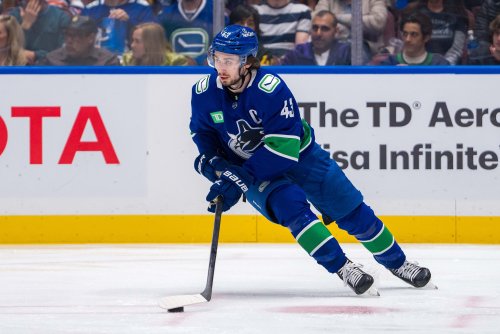
"Bigger, stronger, faster, those are all nice things to have," Bill Guerin said at the Minnesota Wild's end-of-season press conference in April. It felt like the marching orders for this offseason, a pursuit to improve the organization's physical tools.
We saw the Wild take this mentality into the 2023 Draft when they took Charlie Stramel and Rasmus Kumpulainen with their first two picks. Both players were big (6-foot-3 and 6-foot-2, respectively) and strong skaters, especially for their size. As the 2024 Draft neared, the question was whether we would see a similar targeting of physical tools this time.
The answer turned out to be yes, we would. It just wouldn't be the attribute we were expecting. In a draft full of players, notably defensemen, who could make the organization bigger and stronger, Judd Brackett and the Wild's draft table opted for faster.
The two headliners in this category come from their first-and-fourth-round picks, defensemen Zeev Buium and Aron Kiviharju. The two left-shot defensemen share a superpower in their ability to move the puck. Buium showcased this all the way to winning the National Championship for Denver University last season, while Kiviharju's gifts could have catapulted him to the draft's top-10 had it not been for injuries.
Why is that so crucial? Because Minnesota was a slow team last year, and their speed problems started in their own end. Brock Faber was the only defenseman who was elite at breaking out of his own zone, and with Jared Spurgeon out with injury, the team struggled to get the puck up ice.

If they turn out well, Buium and Kiviharju should be able to give Minnesota those clean, easy breakouts that lead to offense. Being among the better passers in the draft should enable Minnesota to play much faster in the neutral and offensive zones.
Their sole forward, second-rounder Ryder Ritchie, also fits the mold of improving Minnesota's pace of play. According to Mitch Brown of Elite Prospects' tracking data, Ritchie is in the 86th percentile of forwards in the transition game. The outlet describes Ritchie as not being "a burner, but his functional pace – the speed at which he makes plays – is among the draft’s highest. At full speed, he dangles opponents, slips passes through them, and shoots in stride."
He fits a similar mold as Kirill Kaprizov and Matt Boldy, where he can move the puck despite lacking elite speed. If the overall goal for the organization is to improve the team's tempo, Ritchie can be a big part of that plan.
Later in the draft, Minnesota started to target defense projects that brought size but also had that skating foundation. Fifth-round pick (No. 140 overall) Sebastian Soini brings a 6-foot-2 frame and solid wheels. "His skating is steady and reliable," reads McKeen's Hockey's report on him, "allowing him to stay in a good position and avoid getting caught flat-footed."
It's not just skating fast, though, Soini's also about playing fast. "Soini's true calling card might be his breakout passing," McKeen's continues. "He has a knack for finding teammates in transition with crisp, accurate outlet passes that jumpstart the offense."
The right-shot defenseman is also solid in his own end. FC Hockey notes Soini is "very strong in front of the net, doesn’t shy away from physicality, and can take an opponent’s stick away at the right times." His June birthday makes him one of the younger players in the class, and he's only played six games in Liiga, meaning Soini will be further off from the NHL than Buium or Kiviharju. But there's potential for Minnesota to develop another David Spacek-type sleeper.
Perhaps the lone exception came in the sixth round when the Wild took a flier on Stevie Leskovar, a tough 6-foot-4 defenseman. Leskovar went through the 2023 Draft, but improved skating and a small uptick in production (12 points in 61 games for Mississauga Steelheads) were enough to make Minnesota spend a late pick on him. Again, Leskovar is a development project, but the Wild have successfully developed big, raw defensemen in Carson Soucy and Nick Seeler.
Minnesota also drafted goalie Chase Wutzke from the Red Deer Rebels, taking him in the fifth round, two picks after Soini. He's a young goalie (July birthday) who put up solid results in the WHL. As a 17-year-old, Wutzke was tied for 12th in his league with a .904 save percentage in 36 games. He out-performed his 19-year-old counterpart, Rhett Stoesser, whose save percentage was just .892 for the season.
The playoffs didn't faze him, either, even as an underdog. "Crucially, he saved his very best hockey for the playoffs, helping Red Deer handily upset the high-powered Medicine Hat Tigers in five games," noted McKeen's. Wutzke had a .924 save percentage in the postseason before going down with injury. McKeen's declared that "Wutzke should be a no-brainer pick for any team that wants to take a medium-upside goalie in the middle rounds," and in the fifth, who are we to argue?
Minnesota's 2024 Draft class might not have been the one we expected, but the Wild entered the weekend looking to get bigger, stronger, and faster. They got faster, and while that's not everything, it's enough for a weekend's worth of work.
Think you could write a story like this? Hockey Wilderness wants you to develop your voice, find an audience, and we'll pay you to do it. Just fill out this form.
-
 2
2






Recommended Comments
Join the conversation
You can post now and register later. If you have an account, sign in now to post with your account.
Note: Your post will require moderator approval before it will be visible.